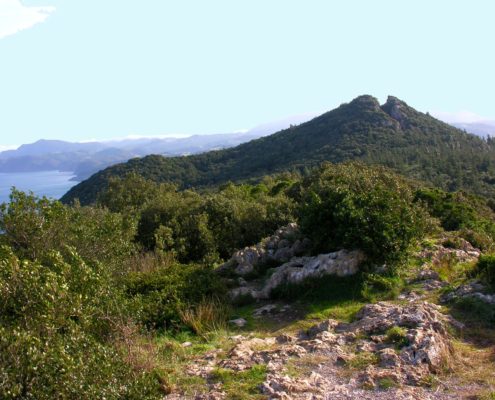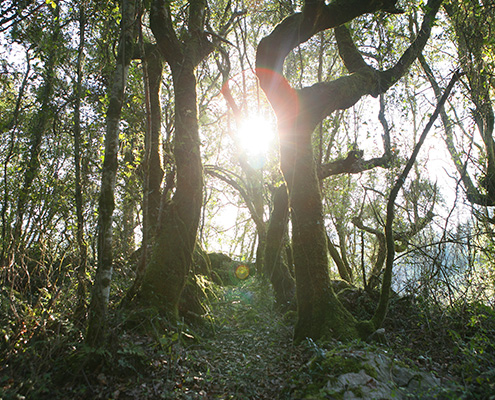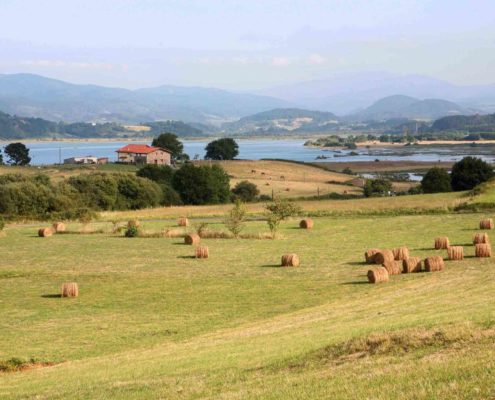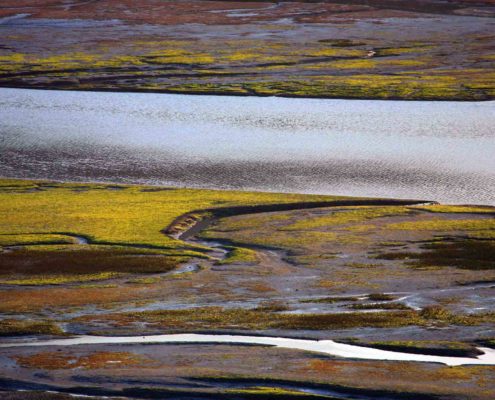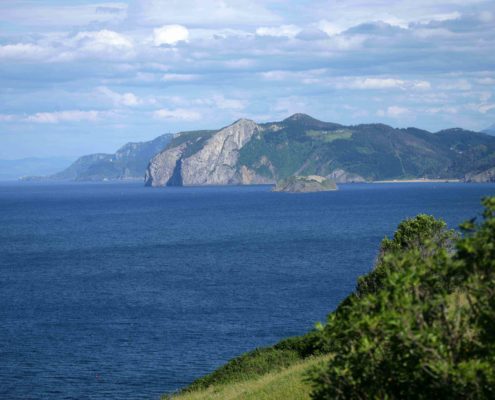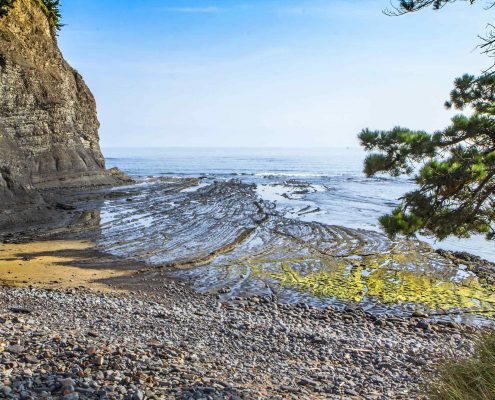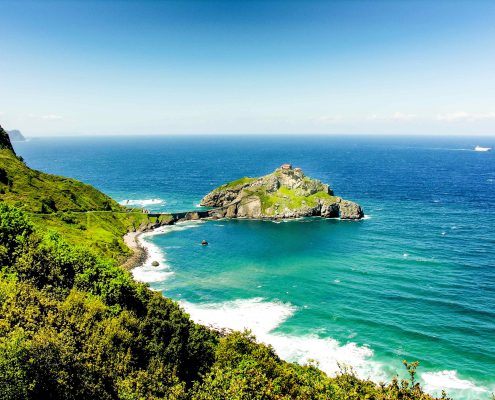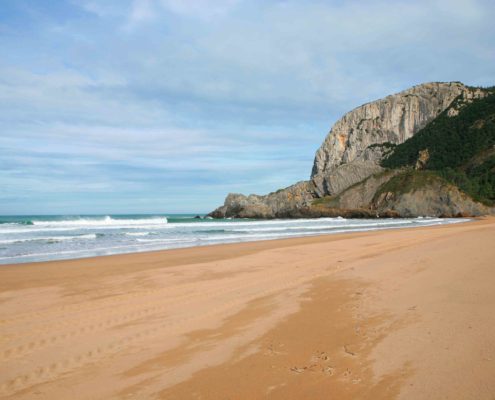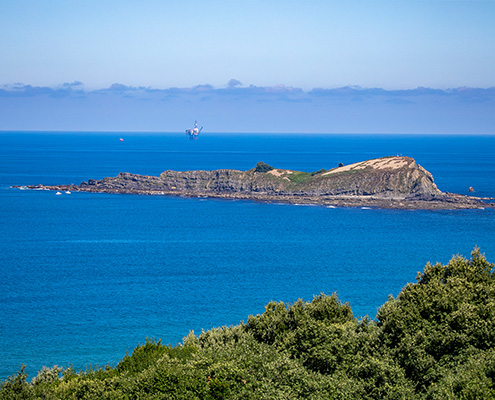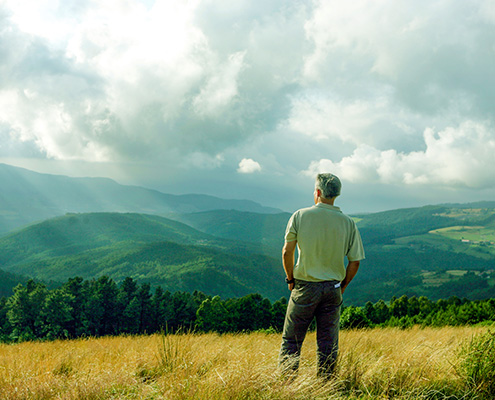Ogoño Cape
This rock, on whose hillside stands the picturesque town of Elantxobe, is a natural lookout that gifts us vertiginous panoramic views over Laga Beach, Izaro, Bermeo and our Cantabrian Sea. This impressive limestone mass of vertical walls can be ascended easily from Elantxobe (1.2 miles). A passage amidst the Cantabrian holm oak forest.
Cantabrian Holm Oak Wood
This is one of the most representative ecosystems of Urdaibai and one of its hallmarks. It strongly marks its landscape and conditions its fauna and uses. They are important forests from an ecological and biogeographic points of view, with plant species that need to deal with water scarcity (especially in summer), develop extensive roots and small coriaceous leaves that can retain moisture, thereby avoiding the loss of water through the regulation of their stomas. The Cantabrian holm oak woods of Urdaibai are home to a diverse fauna. Their closed, thick structure makes this forest mass a protected refuge for many animal species. The most representative Cantabrian holm oak masses in Busturialdea are those that stretch from Ogoño Cape to Ereñozar.
The countryside and the Atlantic forest
The countryside is the natural setting of country houses and inhabited cities, made up of a mosaic of meadows, fields and small adjacent forest formations. Its formation is due to the territory’s agricultural and livestock farming. It is the ecosystem that has sustained direct human intervention, a diverse and harmonious landscape, with the presence of traditional Basque country houses of historical and economic importance and surrounded by fields, different animal species, pastures and forest plantations that give it that special uniqueness and wealth, making it one of the most representative landscapes of the Basque Country.
The tideland
Urdaibai is currently home to some 1,482 acres of tidelands, which present an extensive floodplain. The action of the tides provides this ecosystem with a dynamic component that is very attractive to watch. It is a landscape that changes every few hours. The tideland of Urdaibai is an ecosystem in which, as in few places, the influence of nature merges with the secular practice of man. In an environment that at first glance appears virgin, the expert eye discovers a framework of ancient stone and mud piers or munas, structures for gates no longer in use, semi-dry areas for grass or polders and channels for ancient mills that, built wisely and respecting the environment, have made up a landscape of a great many hues.
The coastline
This zone comprises two clearly different ecosystems: the coast and sea beds.
Coastline: These are areas of extreme conditions, on a steep gradient or open cliff, and exposed to the inclement nature the sea and wind. Few plant species grow on them. San Juan de Gaztelugatxe, Aketxe Island, Matxitxako Cape (Bermeo), the great cliffs of Ogoño Cape, the Antzoras coastline and the Cliffs of Lapatza are just some outstanding spots.
Sea bed: Beyond the coast, the marine environment is an ecosystem full of life and much more difficult to see than that of dry land, with a wealth of flora and fauna that is hard to find in other seas. The temperature of the water fluctuates between 10 ºC and 12ºC in winter, reaching 20ºC in summer. The most usual marine species in the waters that bathe the coastline of Busturialdea are molluscs, such as periwinkles, limpets, oysters, octopus and cuttlefish, crustaceans, such as crangon crangon, goose barnacles, lobster and crab or karramarro and fish, such as bass, mojarra, mackerel, Atlantic horse mackerel and red mullet. You can occasionally see large cetaceans in these waters, such as common dolphins or bottlenose dolphins, the fin whale, common minke whale, sperm whale and killer whale
Ogella Intertidal Zone
At low tide, Ogella Beach, shared by the municipalities of Ea and Ispaster, uncovers its extensive rocky areas and ponds of different depths to showcase a delicate and amazing marine biodiversity of exceptional value on the Cantabrian coast. Among other valuable species is the native algae Fucus chalonii. Ideal for those who love scuba diving. The setting also allows us to become familiar with and enjoy the peculiar geological phenomenon
San Juan de Gaztelugatxe
The small island of Gaztelugatxe, crowned by San Juan Hermitage, is one of the most impressive places you will ever see. During its almost 1,000 years of history, the temple has witnessed acts from piracy and shipwrecks to religious ceremonies in more recent times. The chapel is connected to the coast via a bridge with 231 frayed steps on a flysch rock cliff –on the Peninsula this only exists on the Cantabrian Coast– which is exposed when the tide is low. There is no other better balcony on the Biscay coast than this lookout that, along with the nearby Aketxe rock, forms a natural reserve of great value for being a seabird breeding site. . Read more
Beaches
Busy or quiet, large sandy areas or small, sheltered beaches. The beaches of Urdaibai are many and varied, all with Cantabrian charm, and perfect for enjoying a quiet day in the sun or a day of water sport adventures. Out of the summer season, they are also a great place to enjoy the fierce sound of the sea, to take in the most beautiful nature or to enjoy some time alone.
Beaches of Urdaibai
Always surrounded by mysteries and legends, the islands and small islands of Udaibai are a good example of this. They are continental islands, that is, at some point in their history, there were part of the continent.
Sollube
At 2,240 ft high and thanks to its privileged situation with no other summits around, it offers unbeatable views of the entire county. A “historic” summit, it is one of five beacon mountains, the first of which being the one from which people were called to the General Meetings. It was also witness to bloody battles during the civil war. It is one of the boundaries of Urdaibai Biosphere Reserve and to reach the summit, you can choose from going by foot, for which there are different prepared approaches -from the Alto de Sollube, 1 hour and from Sukarrieta and Pedernales, 2.5 hours- or by car to the summit, where there is a viewpoint.


